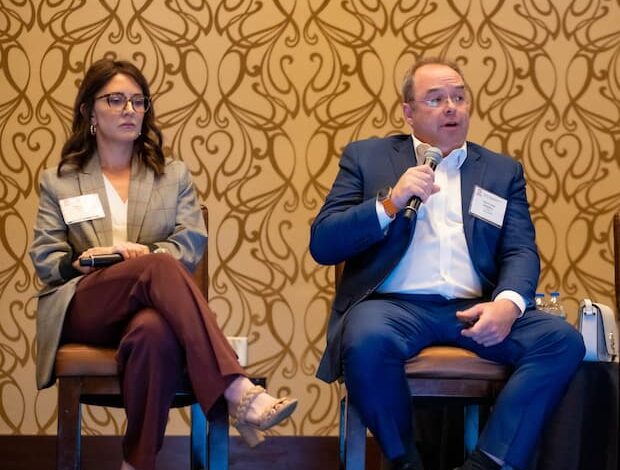Seadrill tackles employee mental health and wellbeing amid growing need for action
As industry begins to recognize scale of employees facing mental health challenges, lessons can be learned from existing efforts

Staff Report
There is an undeniable stigma in society associated with the words “mental health,” yet there is no reason for that negativity. The term is neutral because it simply refers to a person’s psychological, social and emotional wellbeing. You might think about it the way you think about the words “physical health.”
“We all have mental health. We all have physical health. It’s just a condition you have, and it can be positive or negative,” said Neil Forrest, VP of Operational Integrity at Seadrill.
Yet, due to the associated stigma around mental health, many people find it hard to either talk about or seek help when this aspect of their health suffers – and many are suffering. According to a 2021 report from the International SOS Foundation (“Mental Health and the Remote Rotational Workforce”), 40% of the offshore and onshore remote rotational workforce said they experienced suicidal thoughts some or all of the time while on duty. Further, the study found that 29% of survey respondents met the threshold for clinical depression while on rotation. Those are shocking numbers, Mr Forrest said.
For employers, this can mean unhealthy employees and decreased productivity. Especially for remote rotational workers like rig crews, mental health challenges can be exacerbated by factors associated with oilfield life: the remote and isolated locations; confined work and living spaces; separation from family and friends; regular and prolonged periods away from home, to name a few.
Seadrill recognizes this and has taken steps in recent years to implement policies and procedures aimed at improving its employees’ overall wellbeing, believing it will lead to better productivity and engagement, and may even increase employee retention. At the 2023 IADC Annual General Meeting in Austin, Texas, on 9 November, Mr Forrest and his colleague Megan Moon, Head of HR Operations, shared Seadrill’s journey to address mental health over the past five to six years.
While Seadrill has been monitoring and categorizing all of the medical consultations occurring on its rigs since before 2018, so it can understand what issues its crews are facing, the company kicked off a more formalized program, BeWell, in 2019. It incorporates the four pillars of emotional and mental health, social health, physical wellbeing and financial security, Ms Moon explained.
The program aims to raise awareness among employees of each of those four dimensions of mental health, as well as support them in actively managing those dimensions in their own lives. To make sure that crews didn’t become overwhelmed with too much information all at once, the company would tackle just one pillar in each quarter of the year, Ms Moon added.
In 2022, Seadrill stepped up its efforts again by formalizing its Employee Wellbeing Directive. This encompassed the BeWell Program and ensured that mental health would be accounted for in the company’s Behavioral Framework, Health Policy and Diversity Policy. Last year, to make mental health even more visible, it was even incorporated into Seadrill’s overarching company strategy. Among other goals like eliminating dropped objects and delivering environmental stewardship, the strategy also called for “building physical & mental health resilience.”
One example of Seadrill’s efforts to raise employees’ awareness around physical wellbeing is its support of workers’ participation in RigRun. The global program calls for offshore oilfield crews to compete – both individually and as part of the rig they represent – for prizes by becoming more physically active over a six-week period. While the ostensible target here is physical wellbeing, Mr Forrest pointed out that “there’s also a whole social side to this” when employees come together to focus on something fun and to achieve a common goal. “There is a togetherness in this. It’s encouragement by positivity.”
Another way Seadrill is tackling mental health is through psychosocial surveys – psychosocial simply means something that involves both psychological and social aspects. While these surveys had been conducted previously in some operating regions like Norway and Mexico where there is regulator requirement, in 2023 the company standardized the survey process across its global operations. Taking this risk management approach and proactively managing psychosocial risk factors has provided Seadrill with actual data around its employees’ physical and mental health, which are then used to design programs to meaningfully improve their wellbeing.
This HealthyWork Survey, first conducted in September to November last year, was based on the Copenhagen Psychosocial Questionnaire, which is freely and publicly available online. Seadrill also referenced WHO guidance, as well as parts of ISO 45003, to develop the survey. “This is not one of those situations where you’re like, there’s nothing out there that fits what we do. If you do your research, there are plenty of pre-existing standards that you can use to support your own programs,” Mr Forrest said.
For companies looking to start their own employee wellbeing or mental health programs, Ms Moon stressed that frequent communications and consistent messaging is key. “This means sharing information around mental health, having events and figuring out how often you want to communicate that, whether it’s monthly or quarterly, and ensuring that all employees have access to the same information,” she said. “Creating this sense of community and work environment that encourages open dialogue and open communication about the topic is going to help to make sure your messaging comes off as authentic to your employees.”
Another factor for success is how the company’s leaders can role-model well-being behaviors. “Whenever we, as leaders, share our own stories, it’s really impactful,” Ms Moon said, adding that it’s been reported that 90% of employees have never heard a senior leader share a personal experience about mental health. “A good first step in promoting mental health awareness is to get the leaders onboard to role-model the behaviors that we want seen in the organization.” DC




